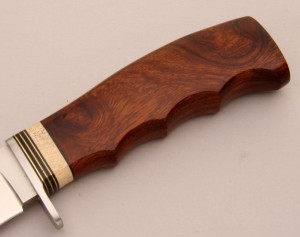D
D-2
An outstanding knife steel, a high-carbon, high chrome tool steel which is often used for the steel cutting dies in every tool and die shop in the U.S.; with 1.5% Carbon, 1% Molybdenum, 12% Chromium and 1% Vanadium, D-2 can be hardened far beyond the favored 60-61 Rc. The first heavy user was Jimmy Lile; the strongest convert has been Bob Dozier. This air hardening steel takes a really good edge, and holds it. This steel has been recently made popular by the great results in the performance of D-2 heat-treated by Dozier.
Dagger
Double edged sheath knife with a symmetrical blade intended for stabbing.
Damascus Steel
Layered Damascus has a wavy pattern on the blade which occurs because there are layers of different steel / iron forged together by repeatedly drawing out, folding, or twisting the different materials together while hot.
There is more mis-information about Damascus steel than about any other subject in the knife world. Bill Moran, the man credited with the reintroduction of Damascus said that if a knife was going to be used then the blade needed a center core of tool steel between two outer layers of Damascus. This statement applies to "layered Damascus" not to what may have been the original Damascus, that is Wootz which is believed to have originated in India. Wootz has been brought back by a group of professors assisted by blacksmith Al Pendray. Layered damascus, that is layers of different steels welded together, was made in Scandinavia, Japan, India, Toledo, Solingen and maybe even in Damascus. Today it is made in all parts of the world for handmade knives, swords and even for production knives. Quality ranges from poor to wonderful.
Damasteel
In the 1970s Era Steel in Sweden and Crucible Metals in U.S.A. patented a process of making steel by blowing finely divided powdered iron, carbon, and other materials into a billet and then applying heat and pressure until a steel is achieved with finer grain, finer carbides, therefore greater strength and better wear resistance. This process is what we know as Powder Metal.
The Swedes went on to invent a method of blowing the particles into patterns; the result is "Damasteel". It has the look of pattern welded Damascus yet is actually a superior, powder metal stainless tool steel.

Desert Ironwood
Today with our customers, Desert Ironwood Burl is the most popular wood for handles. But Burl is now hard to find. Most of the raw material available today has more linear grain. Native to the Sonoran desert (Northern Sonora Mexico and Southern Arizona) it is a very dense tight grained wood, takes a very high polish (does not need to be stabilized) and tends to darken with use and age. The raw material that we buy is harvested from fallen trees.
Distal Taper
Distal taper refers to the change in thickness from the base of the blade to the tip, usually in reference to a sword blade. Greatly affects the handling characteristics and performance of the blade.
Diamond Cross Section Blade
Most often found in a stiletto or rapier blade.
Dirk
The Scottish Dirk is single edged and is a descendent of the Kidney Dagger and was basically used as a left hand knife while fighting with the broadsword. There were also the Dirks carried by midshipmen in the early years of the United States Navy, those usually had slim, curved, single edged blades. This was more a badge of office than a tool.
Today the term dirk is obsolete, these are made only for people who want to dress up in antique clothing for plays and reenactments.
DM1
Dog Leg (Handle Shape)
Also known as Crooked Jack, the handle is like the peanut, but the blades come out of the back.
Dozier, R. L. (Bob)
Prominent Knife maker, Sheath maker (Kydex®) and the manufacturer of the worlds very best belt grinder for knife makers.
Double-End Trapper
See Texas pattern. Blade comes out of each end, usually even end
Drop Forged
Also called closed die forging, the form of the finished item is built into the die, the steel is heated and the hammer forms the plastic steel into the recesses of the die.
Drop Point
A blade design made popular in handmade hunting knives by Bob Loveless beginning about 1969, used earlier by Randall and others.
Dymondwood
This handle material is a wood/resin composite. It can be dyed different colors and is very strong and durable.
